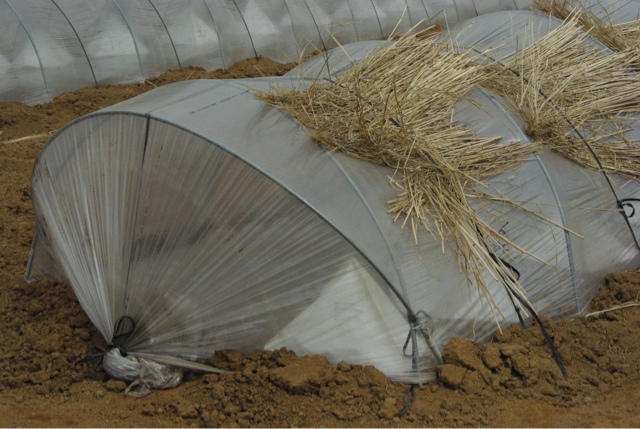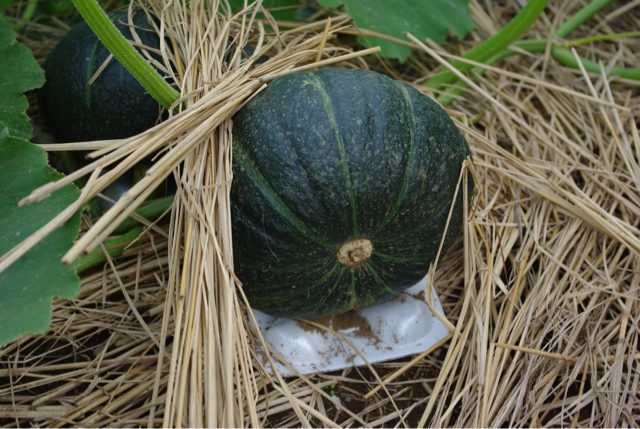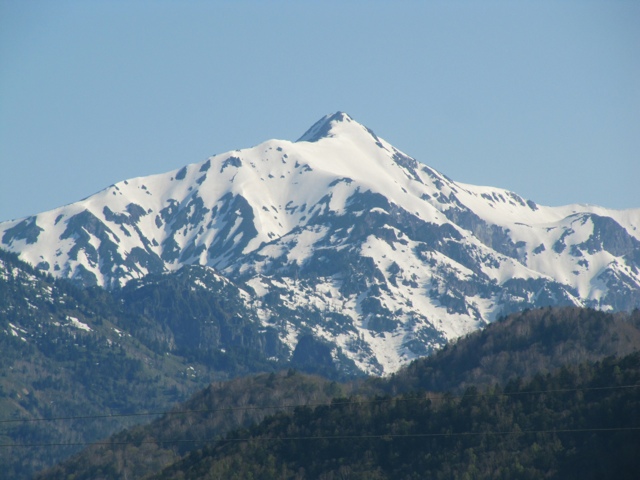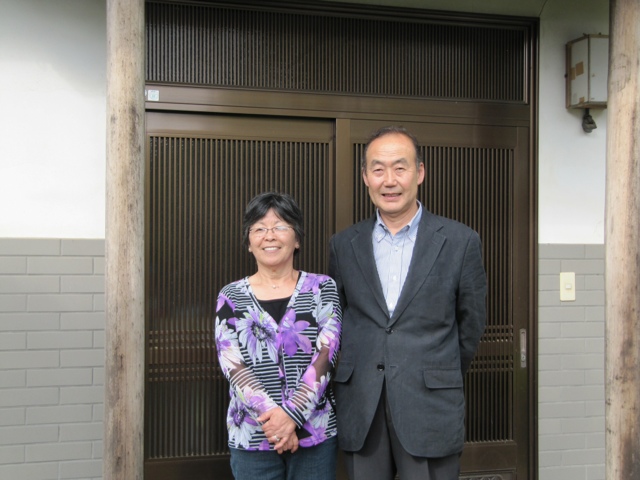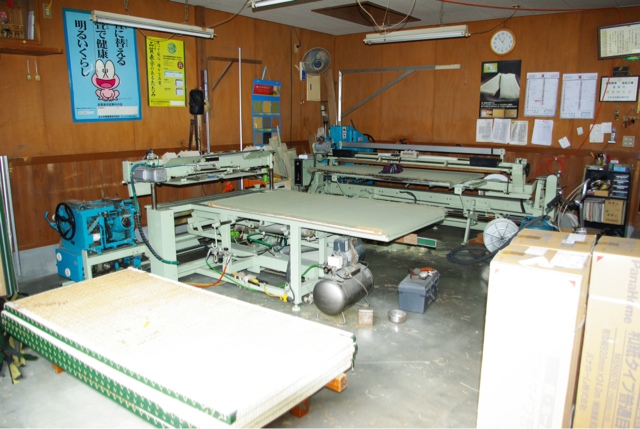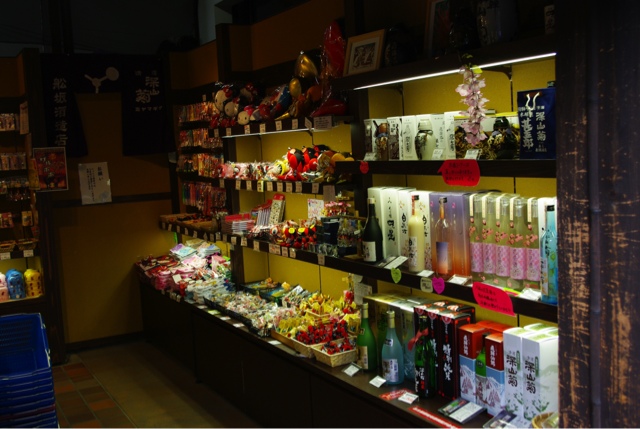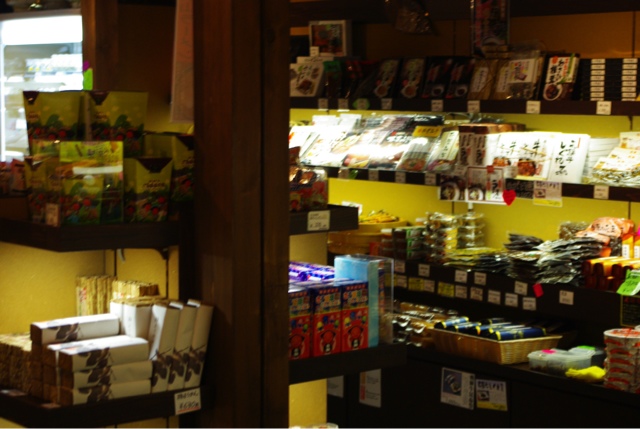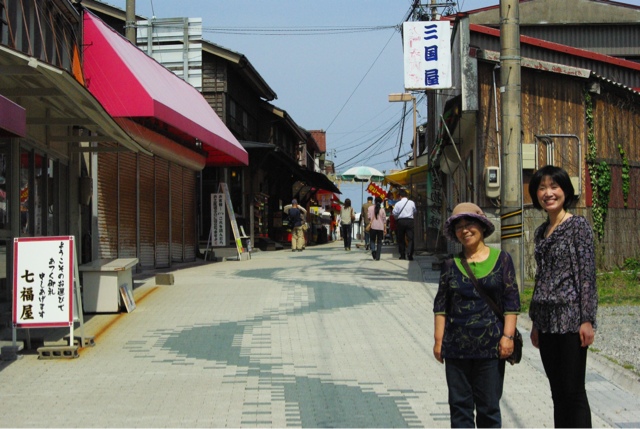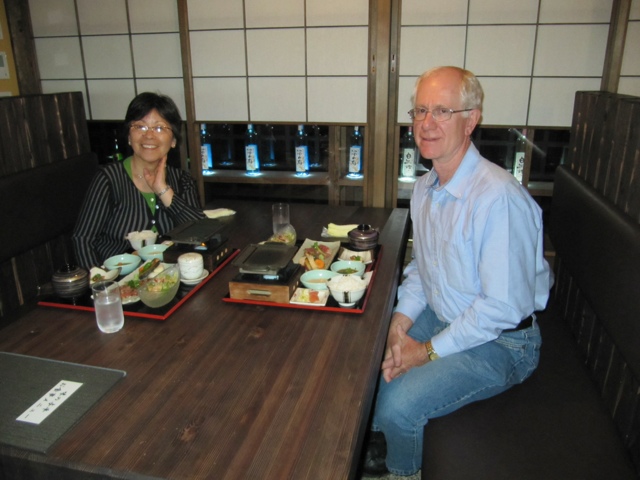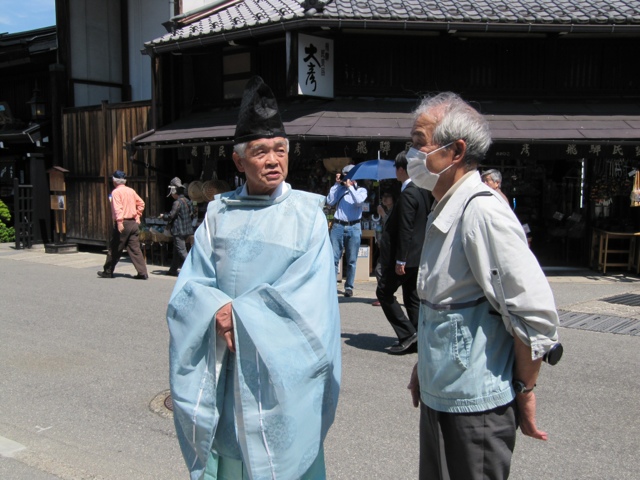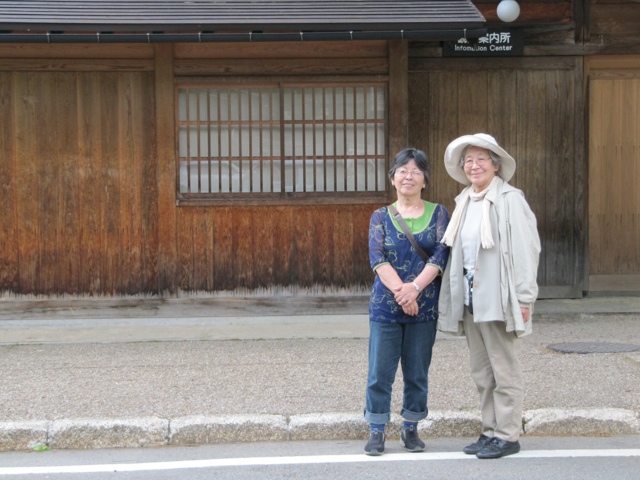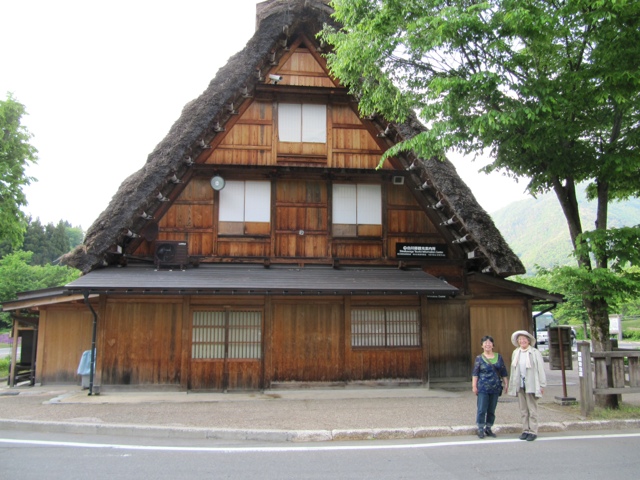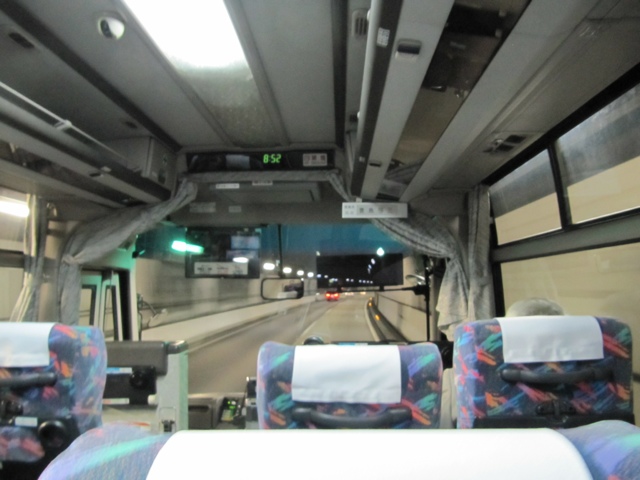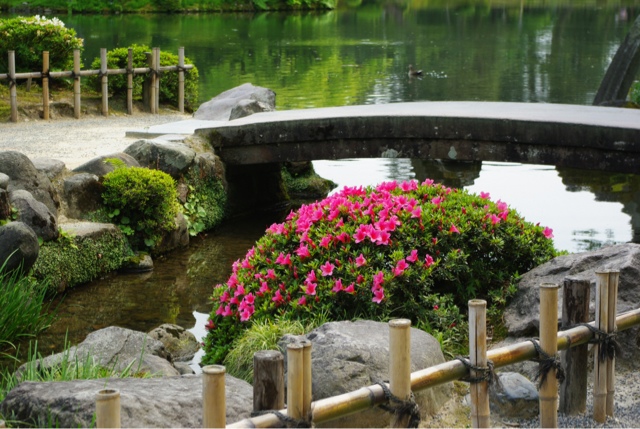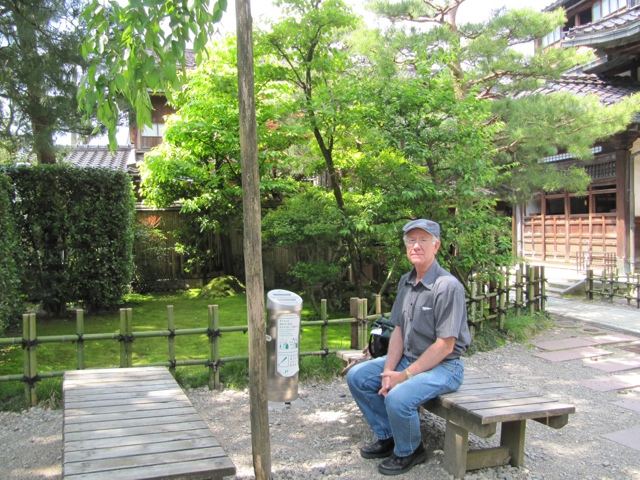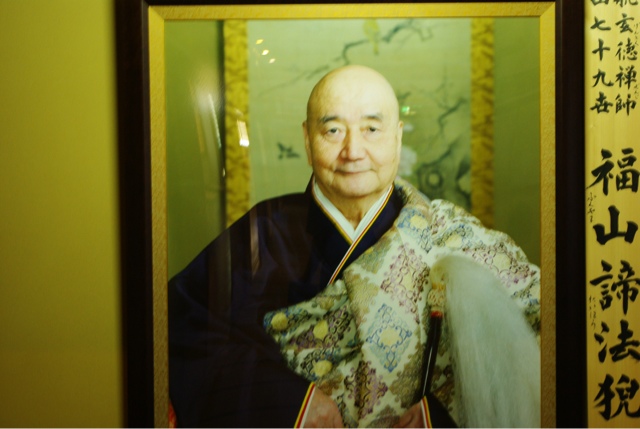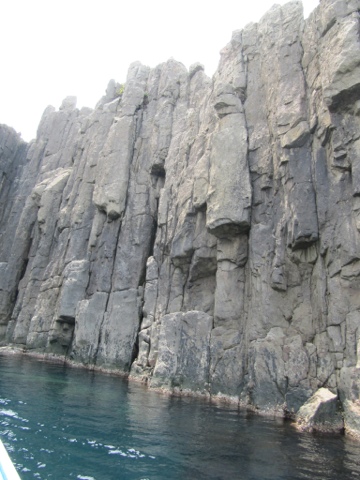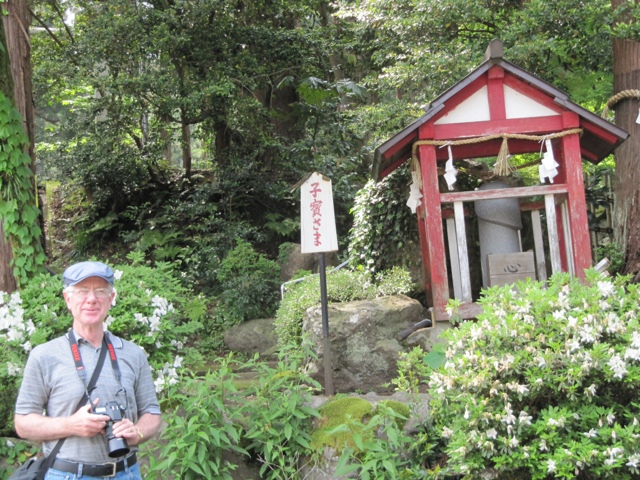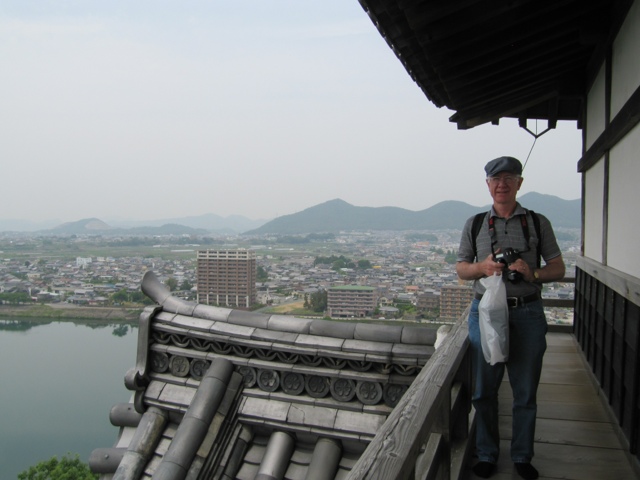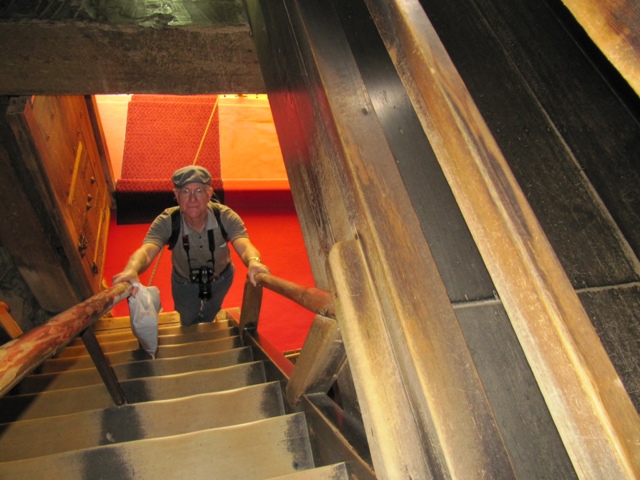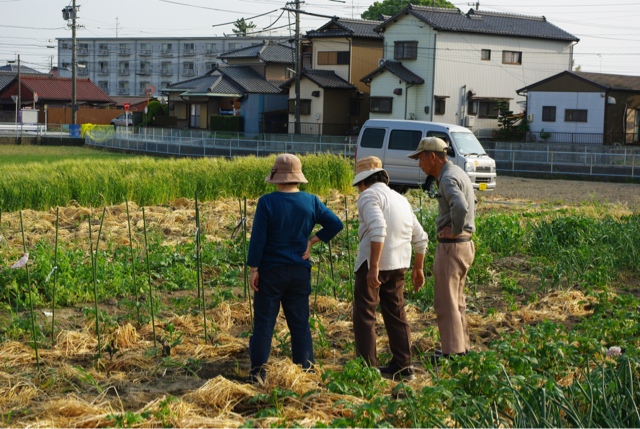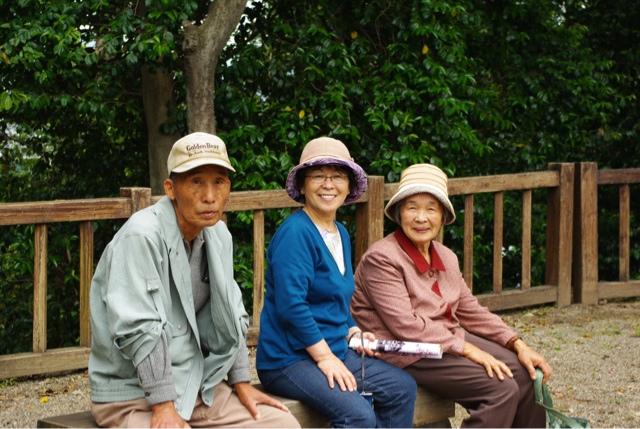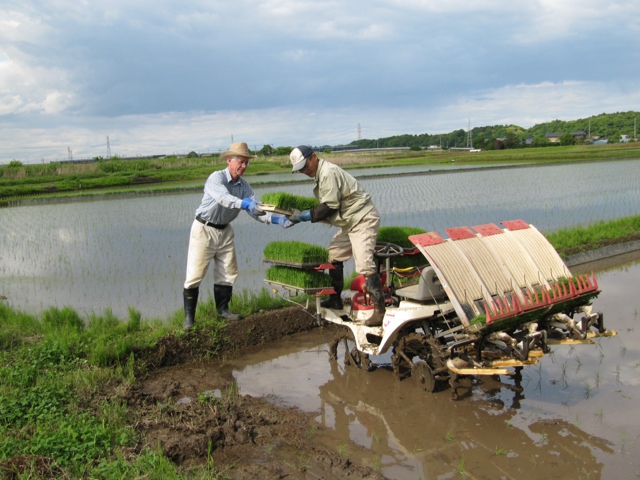Kabocha was created based on the buttercup squash and may be called Japanese pumpkin. It is green outside and orange inside when ripe and maybe about 20cm in diameter. Edosaki is the name of the town nearest our home. We can see the town from the elevated plateau we live on, but it takes about an hour to walk there.
The ground is well cultivated and then vinyl sheeting is stretched over a slightly elevated one meter wide plateau. Holes in the vinyl have the little kabocha plants planted. Each is covered with a little white styrofoam hat and hoops and clear vinyl are stretched around the ground vinyl to create a semi circular tunnel. Then bundles of straw are tied strategically atop the tunnel greenhouses to protect the little white teepees inside from excessive sunshine and possibly to keep some heat in. As the plant grows it tends to push off the styrofoam teepee and these are then removed. The plastic sides of the greenhouse are lifted partially when the sun is shining to prevent heat buildup. As the plants crawl attempting to escape the greenhouse plastic is removed. The straw is placed on the approximately two meter gap of bare ground between adjacent greenhouses.
I suspect there is also some control over the flowers blooming. The female flowers are usually preceded by male flowers. Each plant grows to a vine length of about two meters perpendicular to the rows or former greenhouse structures. I suspect each vine is limited to a defined number of kabocha. Then each growing kabocha is cradled with a white styrofoam bed to prevent any marking of the gourd by the soil. Due to the brand name each gourd can command a price of ¥1500 which at the current exchange rates would be about $20.00 Cdn. I have not seen the farmers carrying shotguns yet, but they sometimes look at me quite suspiciously ;)
They are expected to ripen in June just prior to the hot humid summer which would probably devalue the kabocha. I jokingly told people on our farm that next they will be playing Brahm's Lullaby for the gourds. They seriously thought it was a good idea. My jokes do not translate well?
Everything must be carefully timed in this country. Strawberries had to be ready just prior to Christmas as they are used in large quantities to make Christmas cakes. Carnations are given on Mother's Day, although for most people Mother's Day is not a big deal. We transplanted asters today which hopefully will be ready in early August. They are used to celebrate Obon or Festival of the Ancestors. In Tokyo this takes place in July in conjunction with the original Chinese calendar while the rest of Japan celebrates this in August. Rice is a crop which does not seem to be so tightly controlled. It is not likely to be damaged by frost in this country and when harvested can be easily stored.
Thursday 31 May 2012
Sunday 27 May 2012
Back to Ibaraki
Prior to 0630h on May 23, 2012 we were waiting for the highway bus near the Hida-Takayama train station. Tourism can be tiring and I think we were both ready for a change of pace. Anyway at 0630h punctually as with most Japanese transportation we were on the way. Of course we encountered more tunnels as we were still in mountain country. Our first rest stop was at Hirano Onsen (hot spring resort), where finally we got a decent view of the snow covered mountains. We also saw may beautiful green mountains with many hues of green including the yellow of the bamboo which sheds its leaves in spring. So many things you can see from the bus window, but definitely not easy to photograph. We saw rivers, natural hot water coming out of the side of mountain near the road, dammed lakes for hydroelectric power, a large solar power installation. Soon enough we left the mountains and were back in "civilization" (whatever that word means). Another rest stop and off for Tokyo. There was the occasional bus stop on the side of the highway and near Tokyo the first two passengers got off. Why do they call those roads freeways? Firstly they are very expensive with toll gates that vehicles equipped with transmitters such as our bus just drive through at 20km/hr and they are automatically debited. Secondly after this bus stop we slowed to a crawl almost all the way to Shinjuku. Construction on both sides of the highway and only one lane each way. Well we finally reached Shinjuku with our poor bus driver having driven under trying circumstances for more than six hours. Every time we get to Shinjuku we have trouble figuring out where the train station is. Shinjuku is the upscale shopping area of Tokyo with many high rises all around. The train station is the busiest in the world with at least five train lines including JR (Japan Railways) and we have trouble finding it. Train stations tend to be integrated with shopping centers and I think we all know who gets the most advertising clout.
From Shinjuku we took a train to Ueno and then hopped on a Joban line train bound for the terminal station of Mito. We normally get off at Sanuki and take a two car local train which stops once and then arrives at a dead end in the old part of Ryugasaki City, where we might do a bit of grocery shopping and then take a ¥710 bus ride to within a 15 minute walk of home. But this time Yayoi's connections had connived to have a junior high friend pick us up a Toride station, a short stop at his office nearby, where his assistant had ocha available almost immediately. After finishing our tea and seeing the printed list of classmates he drove us quite a distance to our rural home and then almost immediately drove back to the office.
From Shinjuku we took a train to Ueno and then hopped on a Joban line train bound for the terminal station of Mito. We normally get off at Sanuki and take a two car local train which stops once and then arrives at a dead end in the old part of Ryugasaki City, where we might do a bit of grocery shopping and then take a ¥710 bus ride to within a 15 minute walk of home. But this time Yayoi's connections had connived to have a junior high friend pick us up a Toride station, a short stop at his office nearby, where his assistant had ocha available almost immediately. After finishing our tea and seeing the printed list of classmates he drove us quite a distance to our rural home and then almost immediately drove back to the office.
Tatami Factory
Every truly Japanese style home or apartment has at least one room that is floored with tatami or rice straw mats. Room size was traditionally measured by the number of tatami. The tatami room is either a bedroom or a guest room where ocha (green tea) could be served (frequently in less than 10 minutes after entering a home, even if by surprise). When you enter a Japanese home your shoes come off and what a pain this can be when one is entering and exiting multiple tourist sites that require shoe removal. I have purchased shoes that appear normal with laces, but there is a short zipper alongside the laces that quickly allows you to jettison the shoes. Inside the home or tourist site you may or may not be provided with slippers. If so these must come off when entering the tatami room. The photographs illustrate a tatami room and a typical small factory that compresses the straw like material to make a mat. The tatami are somewhat softer than a wooden floor and therefore more suitable when sleeping on the floor.
Omiyagi
If you plan on coming to Japan you had better learn this word and get involved. In North America when one is invited to the home of someone you frequently may bring a little something such as flowers. In Japan this bad habit has progressed to be a multi-billion dollar industry. There are thousands of shops selling sweets, crackers, etc. that are located at train stations, highway rest stops, department stores, tourist areas, temples and everywhere. Each city has certain items they are renowned for and so of course you find these in many shops along the street. I of course would like to buy and eat one of everything, but generally these are purchased to be given to the people you are going to see, family you are coming home to, a friend or whomever. All too often there is some sort of reciprocation involved and the shop owners continue to survive.
Traditionally when we visited Japan we tried to bring things from Canada that could not be found in Japan, but that has become virtually impossible or the gift is somewhat impractical such as Canadian fur. Japanese stores sell maple syrup, maple cookies and Canadian alcohol products. Alcohol is found in any grocery store and even in some vending machines. So anyway on this prolonged visit we have begun to operate the way Japanese people might. We are in city A, buy a specialty of A and bring it to someone in city B.
Traditionally when we visited Japan we tried to bring things from Canada that could not be found in Japan, but that has become virtually impossible or the gift is somewhat impractical such as Canadian fur. Japanese stores sell maple syrup, maple cookies and Canadian alcohol products. Alcohol is found in any grocery store and even in some vending machines. So anyway on this prolonged visit we have begun to operate the way Japanese people might. We are in city A, buy a specialty of A and bring it to someone in city B.
Takayama Edo Era Houses
Hida-Takayama is in the mountains and somewhat difficult to get to by any direct route from Tokyo. For us it was easier going to Nagoya then Fukui and finally Takayama. Regardless it appears to be a very popular place as we saw as many foreigners here as anywhere else in Japan. For me this was a little disconcerting. Like Kobe and Yonezawa it is renowned for its marbled beef. Very delicious, but also very expensive.
We checked into the Country Hotel and then went for a walk in the heritage area of old blackened wood houses. The evenings are bright a little longer and we found a very nice restaurant that served combination dinners (limited menu) including the marbled beef - oishii!
The next day we wandered around, saw a farmer's market, the Kusakabe heritage house, various shrines including the Sakurayama-Hachimagu shrine.
We saw many gift shops selling various items including the pickled radish famous here, a furniture store ($$$ or is that ¥¥¥) and metal sculptures which the locals are proud of.
We had coffee in a quaint little shop along with zenzai (azuki beans in a sweet sauce - my favourite) and a sliver of a skewer with three tiny pieces of beef (1cm by 3 cm) for 600¥ or Canadian $8.00 - outrageous, but very tasty.
This was the off season here so not all businesses were open and supposedly not that many people, but incredibly buses were meandering through the narrow streets of the old area loaded with tourists - ridiculous.
We photographed a Shinto priest on the street getting ready to perform a ceremony for protection against (guess what?), no not foreigners, but rather against fire, which in these streets would be catastrophic as the houses have no space between them.
Click on link to see photographs on Picasa of Takayama Edo Era.
Lady from Takayama
As we sat on 'cylinders' at the bus stop in Kanazawa waiting for the tunnel highway bus, the lady sitting with her back to us, turned and asked Yayoi about her necklace. It has a couple of pearls pierced by what appears to be heavy gauge clear monofilament fishing line which is virtually invisible. They chatted a bit and we got on the bus. She appeared to be happy to be heading back to her home in Takayama. When we stopped in the touristy town of Shirakawa we got a couple of photographs of her.
Shirakawa is famous for its very old houses thatched with straw and with an unusual peak system allowing egress in cases of heavy snowfalls two stories thick.
Anyway back on the bus, still missing photographs of the snow covered mountains in the distance, I watched our lady near the front of the bus. In Japan people get on the train or bus and immediately fall asleep. This lady may have dozed a little, but as we got closer to Takayama she became noticeably more alert. She was excited about her snow covered mountains, which to her meant home. She turned and made sure we were aware of them. In Takayama we got off the bus and she wished us well.
Click on link to see photographs on Picasa of Shirakawa.
Shirakawa is famous for its very old houses thatched with straw and with an unusual peak system allowing egress in cases of heavy snowfalls two stories thick.
Anyway back on the bus, still missing photographs of the snow covered mountains in the distance, I watched our lady near the front of the bus. In Japan people get on the train or bus and immediately fall asleep. This lady may have dozed a little, but as we got closer to Takayama she became noticeably more alert. She was excited about her snow covered mountains, which to her meant home. She turned and made sure we were aware of them. In Takayama we got off the bus and she wished us well.
Click on link to see photographs on Picasa of Shirakawa.
Kanazawa to Takayama
We took the highway bus to Takayama leaving late in the afternoon. This is mountain country and the scenery is incredibly beautiful. Throw away the tera (temples), the jinja (shrines), the shiro (castles) and maybe even the gardens and give us the green and the white mountains, the green and blue ocean and the mountain streams and waterfalls!
Anyway I was feeling sorry for the bus driver on this ride, not because he was driving and could not enjoy the scenery with us, but because none of us spent much time enjoying the scenery. The reason being that we were driving on tunnel highway through the Hida mountains. You briefly exited one tunnel and another one would appear. What monotonous driving for our driver! One tunnel was 11 eleven kilometers long.
We made a brief stop at Shirakawa which focused attention on the next human interest story lady from takayama.
Anyway I was feeling sorry for the bus driver on this ride, not because he was driving and could not enjoy the scenery with us, but because none of us spent much time enjoying the scenery. The reason being that we were driving on tunnel highway through the Hida mountains. You briefly exited one tunnel and another one would appear. What monotonous driving for our driver! One tunnel was 11 eleven kilometers long.
We made a brief stop at Shirakawa which focused attention on the next human interest story lady from takayama.
Kenrokuen Garden in Kanazawa
May 21, 2012
There are many beautiful gardens in Japan, but this one and Ritsurin Garden in Takamatsu are probably two of the nicer ones.
Kenrokuen has greenery, flowers, water features, plum trees (green plums make a very nice drink) and a fountain that is powered by natural water pressure created by different water levels in two ponds. Japan has no shortage of water and hopefully they can keep it clean as it flows to the ocean.
Click on Kenrokuen Garden to see photographs on Picasa.
There are many beautiful gardens in Japan, but this one and Ritsurin Garden in Takamatsu are probably two of the nicer ones.
Kenrokuen has greenery, flowers, water features, plum trees (green plums make a very nice drink) and a fountain that is powered by natural water pressure created by different water levels in two ponds. Japan has no shortage of water and hopefully they can keep it clean as it flows to the ocean.
Click on Kenrokuen Garden to see photographs on Picasa.
Saturday 26 May 2012
Ninja Dera
May 21, 2012
This is actually called Kanazawa Myoryuji and is a temple of the Nichiren Sect. It is not especially beautiful, has nothing to do with ninja, but is commonly called Ninja-Dera because of the many tricks the building contains such as secret staircases, trap doors and escape routes. These features were incorporated hundreds of years ago to aid in evading enemies. From outside the temple appears to be a two story building, but is actually a four story building with seven layers. The building is old and has withstood storms and heavy snowfalls due to the immense beams used in its construction. Unfortunately photographs of the inside were strictly forbidden.
This is actually called Kanazawa Myoryuji and is a temple of the Nichiren Sect. It is not especially beautiful, has nothing to do with ninja, but is commonly called Ninja-Dera because of the many tricks the building contains such as secret staircases, trap doors and escape routes. These features were incorporated hundreds of years ago to aid in evading enemies. From outside the temple appears to be a two story building, but is actually a four story building with seven layers. The building is old and has withstood storms and heavy snowfalls due to the immense beams used in its construction. Unfortunately photographs of the inside were strictly forbidden.
Eiheiji
May 20, 2012
When Yayoi mentioned that we were going to Fukui prefecture our people here in Ibaraki were quite excited about our visiting this "temple of eternal peace". This is a Soto Zen temple which was founded by Dogen zenji in the year 1244. One sees so many temples and shrines that they cease to impress, but this Buddhist temple is quite impressive.
Only the Rinzaiji temple in Shizuoka which we were very fortunate to see on an earlier trip to Japan (open to the public one day a year) in my opinion is more beautiful. It was where Ieyasu Tokugawa was trained as a child hostage and today continues to be a place of training.
Eiheiji is used to train both priests and lay people. Satomi Furuki who took care of us for the weekend practiced zazen or seated meditation here at one time as part of work. She was "whacked" many times when she failed to meet standards during this one day session.
Each priest trainee has one (1 meter by 2 meter) tatami mat on a raised platform on which they do zazen, and eat and sleep. The food is strictly vegetarian. Talking or reading are not permitted. They go to bed at 9pm and get up at 3:30am. They bathe whenever the date contains a 4 or a 9.
It is permitted to take photographs of the priests or trainees.
Click on Eiheiji Tera to see photographs on Picasa.
When Yayoi mentioned that we were going to Fukui prefecture our people here in Ibaraki were quite excited about our visiting this "temple of eternal peace". This is a Soto Zen temple which was founded by Dogen zenji in the year 1244. One sees so many temples and shrines that they cease to impress, but this Buddhist temple is quite impressive.
Only the Rinzaiji temple in Shizuoka which we were very fortunate to see on an earlier trip to Japan (open to the public one day a year) in my opinion is more beautiful. It was where Ieyasu Tokugawa was trained as a child hostage and today continues to be a place of training.
Eiheiji is used to train both priests and lay people. Satomi Furuki who took care of us for the weekend practiced zazen or seated meditation here at one time as part of work. She was "whacked" many times when she failed to meet standards during this one day session.
Each priest trainee has one (1 meter by 2 meter) tatami mat on a raised platform on which they do zazen, and eat and sleep. The food is strictly vegetarian. Talking or reading are not permitted. They go to bed at 9pm and get up at 3:30am. They bathe whenever the date contains a 4 or a 9.
It is permitted to take photographs of the priests or trainees.
Click on Eiheiji Tera to see photographs on Picasa.
Tojinbo
Satomi told us that this area is infamous for multiple suicides. Some people apparently threatened to jump and were told by guides that th location they chose was not suitable. Another site was more suited to ensuring death. Morbid or what? Another story concerns a priest being pushed off the cliffs after becoming the losing part of a love triangle.
To read about this area click on Tōjinbō.
Like most tourist attractions in Japan the walkway leading to this one is lined with countless souvenir and food shops. I love "budo" or grape ice cream and "ika" or baked or roasted whole squid - yummy. Anyway we reached the rocks on the seashore without my succumbing to any such temptations.
We clambered about the rocks, encountered some young men, one of whom took a photograph of two of us and informed us that when in junior high school had jumped from the rocks into the ocean. I believe him, but could never see myself doing this. It is quite a height and thankfully for him the water is quite deep as well where he jumped. After taking too many photographs Satomi, Yayoi and I hopped on a boat for a half hour ride viewing the rocks from the ocean and seeing various other things such as the fishermen on isolated rocks.
Click on Tojinbo Suicide Rock to see photographs on Picasa.

To read about this area click on Tōjinbō.
Like most tourist attractions in Japan the walkway leading to this one is lined with countless souvenir and food shops. I love "budo" or grape ice cream and "ika" or baked or roasted whole squid - yummy. Anyway we reached the rocks on the seashore without my succumbing to any such temptations.
We clambered about the rocks, encountered some young men, one of whom took a photograph of two of us and informed us that when in junior high school had jumped from the rocks into the ocean. I believe him, but could never see myself doing this. It is quite a height and thankfully for him the water is quite deep as well where he jumped. After taking too many photographs Satomi, Yayoi and I hopped on a boat for a half hour ride viewing the rocks from the ocean and seeing various other things such as the fishermen on isolated rocks.
Click on Tojinbo Suicide Rock to see photographs on Picasa.

Toilet Facilities
In Japan one needs to make careful distinctions between rooms used for different purposes which in a North American home would all be found in the washroom or bathroom. In Japan a bathroom or "ohuro" is used only for bathing. The room where you make yourself presentable in the morning is frequently part of the laundry room. The toilet is a tiny room all by itself.
Anyway Satomi Furuki was very proud to take us to what may be one of the fanciest toilets in Japan, bird songs, Japanese garden and decorated. We were taken off guard and did not get proper photographs to do this place justice.
Anyway Satomi Furuki was very proud to take us to what may be one of the fanciest toilets in Japan, bird songs, Japanese garden and decorated. We were taken off guard and did not get proper photographs to do this place justice.
Guess what
Every Shinto shrine has a reason for its existence and the grounds of a place such as Tsurugi Jinja (shrine) can have a number of sites dedicated to topics such as safety in childbirth. Well the two ladies were having quite a chuckle at my expense concerning the topic in the photograph.
Japan Sea
May 19, 2012 we said goodbye to the Saito family and left Nagoya and crossed over Japan towards Fukui close to the Japan Sea. We had been avoiding western Japan because in the winter it tends to be colder and has a lot of snow. Eastern Japan is moderated by a warm ocean current.
We took a highway bus and were picked up at Takefu just prior to Fukui by Satomi Furuki. This began a two day whirlwind tour of this part of Japan. Satomi was in Winnipeg about the year 2000 and did a wonderful job of touring us by car around her area of Japan which Yayoi and I had never seen. She like so many people we have met is a very generous warm hearted and capable person.
We had a very nice soba (buckwheat) noodle lunch and then went to see Tsurugi Jinja (shrine). This shrine was used by the Oda Nobunaga family four hundred years ago. Then we drove along a beautiful sea coast highway viewing the Japan Sea and the interesting rock formations. Later we checked into a Japanese style inn or Ryokan, where three of shared a room and where the toilet facilities were shared by all the rooms on our floor. We went a few kilometers up the road to an Onsen or hot spring and had a bath in pools outdoors overlooking the ocean. Paradise!
Satomi kept emphasizing that we should come back in winter. It does not snow right on the coast and the waves are huge then even washing over the highway. She is very proud of her part of Japan.
Then back to the Ryokan for a fabulous countless course dinner. This area is famous for crab (crab season is in winter normally) and we were able to eat crab and many other dishes until we were 'stuffed to the gills'.
In the morning we had a fabulous breakfast and then headed off to see Tojimbo (suicide rocks) and a very famous Buddhist temple (tera) called Eiheiji used for training priests or monks and also for one day sessions for business employees.
Click on link to see photographs on Picasa Japan Sea.
We took a highway bus and were picked up at Takefu just prior to Fukui by Satomi Furuki. This began a two day whirlwind tour of this part of Japan. Satomi was in Winnipeg about the year 2000 and did a wonderful job of touring us by car around her area of Japan which Yayoi and I had never seen. She like so many people we have met is a very generous warm hearted and capable person.
We had a very nice soba (buckwheat) noodle lunch and then went to see Tsurugi Jinja (shrine). This shrine was used by the Oda Nobunaga family four hundred years ago. Then we drove along a beautiful sea coast highway viewing the Japan Sea and the interesting rock formations. Later we checked into a Japanese style inn or Ryokan, where three of shared a room and where the toilet facilities were shared by all the rooms on our floor. We went a few kilometers up the road to an Onsen or hot spring and had a bath in pools outdoors overlooking the ocean. Paradise!
Satomi kept emphasizing that we should come back in winter. It does not snow right on the coast and the waves are huge then even washing over the highway. She is very proud of her part of Japan.
Then back to the Ryokan for a fabulous countless course dinner. This area is famous for crab (crab season is in winter normally) and we were able to eat crab and many other dishes until we were 'stuffed to the gills'.
In the morning we had a fabulous breakfast and then headed off to see Tojimbo (suicide rocks) and a very famous Buddhist temple (tera) called Eiheiji used for training priests or monks and also for one day sessions for business employees.
Click on link to see photographs on Picasa Japan Sea.
InuyamaJo Castle
I tend to classify "shiro" or castles in Japan as being of two types. The one type consists of showy castles such as Osaka-Jo or Himeji-Jo. They tend to be large non-wooden structures designed functionally, true, but really intended to impress visitors. They were usually built after Japan began entering its peaceful phase in the 1600's. The second type of castle is usually a wooden structure built before 1600 and tend to be smaller than the showy castles. Two prime examples of this are Matsumoto-Jo and Inuyama-Jo (Hakutei). These were built during Japan's warring era. Inuyama-Jo is the oldest surviving castle in Japan. It was built in 1537 by an uncle of Oda Nobunaga who was the first of the three famous Japanese leaders who attempted to unify Japan and end the warring phase. Had Oda Nobunaga survived and succeeded, I suspect Japan might be a very different country than it is today. Nobunaga was succeeded by Toyotomi Hideyoshi and finally Ieyasu Tokugawa who brought peace to Japan albeit a feudal society. The latter two leaders were especially notorious for building structures at any cost designed to impress the viewer.
Anyway I digress. I much prefer the latter type of castle with its narrow steep wooden staircases and narrow scary balconies outside of the castle encompassed by low balustrades. The castle consists of four levels protected by a two storey stone wall. Like most castles it is built on an elevated area and is surrounded by water, either a river or moats. In the case of Inuyama-Jo the nearby river is unusually beautiful with the presence of large boulders in the water giving the appearance of a designed garden with the boulders representing islands.
Click on link to see photographs on Picasa Inuyama Jo.
Anyway I digress. I much prefer the latter type of castle with its narrow steep wooden staircases and narrow scary balconies outside of the castle encompassed by low balustrades. The castle consists of four levels protected by a two storey stone wall. Like most castles it is built on an elevated area and is surrounded by water, either a river or moats. In the case of Inuyama-Jo the nearby river is unusually beautiful with the presence of large boulders in the water giving the appearance of a designed garden with the boulders representing islands.
Click on link to see photographs on Picasa Inuyama Jo.
Friday 25 May 2012
Fumiko Saito
The "soba lady" (soba is buckwheat) first came to Winnipeg, Manitoba about 2004. She did not know a word of English, but had a plan to grow Japanese buckwheat in the Brandon area. Buckwheat is used to make noodles that are usually eaten cold in the summer time. In the city of Takefu we ate soba noodles made of 100% buckwheat flour with Satomi Furuki. Delicious!
Due to Saito-san going to the Japanese Culture Centre in Winnipeg she connected with us. She was so passionate, that suddenly we were enlisted into planting buckwheat throughout our flower garden. Being interested in farming she spent a few days on the farm with cousin Bill and Carol Ann. She was very impressed with the two of them and she left a lasting impression on them.
After a few years she tried to ship the crop, but ran into snags due to not having a full shipping container. She also tried to grow buckwheat in Hokkaido, but farmers there were not cooperative.
She lives in Nagoya and has two fields and a greenhouse a drive away from the her house. Apparently she also has a rental business renting out shop or storage space.
She has had other schemes, but her current plan is to grow olives on Shoodojima Island in the inland sea between Shikoku and Honshu. This island is close to Naoshima Island which we have visited. These islands are near Takamatsu where the climate tends to be drier than other areas of Japan. She has already planted 200 trees and goes to the island every month for a few days to take care of the trees. The olives should start to pay off in seven years. Fumiko is 74 years old and appears to have energy to spare. She plans on building a small home near the olives for her working retirement.
Many people are building the equivalent of summer cottages here. The island has a lot of wildlife including wild boar (inoshishi), Japanese deer (shika) and Japanese macaque monkeys (saru). The deer particularly are a pest with respect to the olive plantation.
Due to Saito-san going to the Japanese Culture Centre in Winnipeg she connected with us. She was so passionate, that suddenly we were enlisted into planting buckwheat throughout our flower garden. Being interested in farming she spent a few days on the farm with cousin Bill and Carol Ann. She was very impressed with the two of them and she left a lasting impression on them.
After a few years she tried to ship the crop, but ran into snags due to not having a full shipping container. She also tried to grow buckwheat in Hokkaido, but farmers there were not cooperative.
She lives in Nagoya and has two fields and a greenhouse a drive away from the her house. Apparently she also has a rental business renting out shop or storage space.
She has had other schemes, but her current plan is to grow olives on Shoodojima Island in the inland sea between Shikoku and Honshu. This island is close to Naoshima Island which we have visited. These islands are near Takamatsu where the climate tends to be drier than other areas of Japan. She has already planted 200 trees and goes to the island every month for a few days to take care of the trees. The olives should start to pay off in seven years. Fumiko is 74 years old and appears to have energy to spare. She plans on building a small home near the olives for her working retirement.
Many people are building the equivalent of summer cottages here. The island has a lot of wildlife including wild boar (inoshishi), Japanese deer (shika) and Japanese macaque monkeys (saru). The deer particularly are a pest with respect to the olive plantation.
Japanese Food
No, this does not mean sushi and sashimi (raw fish). If you want to be a guest in Japan I very strongly recommend you learn to eat anything before you come. Some of the horror stories I hear about fussy people coming here make me exclaim, maybe you should stay home! Japanese people eat almost anything and everything. Tourism in Japan (television, magazines and tourism brochures support this) is composed of two facets sight seeing and food.
Restaurants in Japan usually have excellent food, too, often better than home cooked food. Chefs can take anything and make it taste delicious. We have learned that the best way to eat here is to never suggest what type of food to eat or emphasize liking a certain food. It is much better if the hosts recommend the type of food. That way you have the opportunity to eat new foods and appreciate the specialties each area of Japan prides itself on. One current fad in Japan is hormone meats, which means eating those parts of animal we might otherwise throw away. In Fukuoka we went to a chicken restaurant where we ate 'all parts of the chicken except the feathers'. Gristle is not my favourite, but when in Rome... In a grocery store, chicken breast meat is the cheapest.
Another class of food which has surprised me, is the Japanese interpretation of Italian food. I have had delicious pizza and pasta. The last pasta I ordered was spaghetti with "natto" or fermented beans and pickled plum or "umeboshi". The menu called it 'fermentatta'. Only an expert chef could make this combination taste so good. Apparently even half of the Japanese people will not eat "natto".
In the ryokan or Japanese style inn we stayed in near Fukui on the Japan sea, crab was the specialty so we ate crab, but also had a crispy baked fish which could be eaten, bones and all. Another dish contained a shell fish that was still alive before being cooked at the table.
Restaurants in Japan usually have excellent food, too, often better than home cooked food. Chefs can take anything and make it taste delicious. We have learned that the best way to eat here is to never suggest what type of food to eat or emphasize liking a certain food. It is much better if the hosts recommend the type of food. That way you have the opportunity to eat new foods and appreciate the specialties each area of Japan prides itself on. One current fad in Japan is hormone meats, which means eating those parts of animal we might otherwise throw away. In Fukuoka we went to a chicken restaurant where we ate 'all parts of the chicken except the feathers'. Gristle is not my favourite, but when in Rome... In a grocery store, chicken breast meat is the cheapest.
Another class of food which has surprised me, is the Japanese interpretation of Italian food. I have had delicious pizza and pasta. The last pasta I ordered was spaghetti with "natto" or fermented beans and pickled plum or "umeboshi". The menu called it 'fermentatta'. Only an expert chef could make this combination taste so good. Apparently even half of the Japanese people will not eat "natto".
In the ryokan or Japanese style inn we stayed in near Fukui on the Japan sea, crab was the specialty so we ate crab, but also had a crispy baked fish which could be eaten, bones and all. Another dish contained a shell fish that was still alive before being cooked at the table.
Thursday 24 May 2012
Traveling in Japan
Traditionally Yayoi and I would come to Japan and do the vast majority of our travel by train or shinkansen (bullet train). Previously we also experienced car rides, one domestic plane ride, one overnight intercity bus, the occasional short distance city bus ride and some ferry boat rides. We walked and climbed stairs both in train stations and in temple or shrine venues. Many Japanese people have strong calf muscles.
Things have changed. Shinkansen travel is quite expensive so we have begun using more long distance buses and new discount domestic airlines such as SkyMark and Peach when available as not all cities have airports or flights. More and more people in Japan are becoming dependent on cars. There are many more bicycles in Japan than in North America, but I believe their use is decreasing. About 90% of the bicycles in Japan look identical, similar to what would be considered a girl's bike in North America.
During this stay in Japan we have done more walking, ridden bicycles as described in an earlier BLOG, driven cars which we ever did before and travelled by rocket ferry boat.
We have learned to stay in business hotels close to train stations near which highway bus depots are also found. They usually include a reasonable breakfast.
But travel can be mentally tiring. On May 15, 2012 we left our rural home and set out for the big city. We arrived in Nagoya by bus and trundled off to find the Summit hotel. We checked in and then went to the neighbouring building to find our room. It smelled smoky. A phone call to the front desk resulted in someone coming to take us to another room. We began settling in when a knock was heard. Eyeglasses had been left in the first room and discovered during a quick check by our man from the front desk. Time to relax, have a shower and sleep. In the morning there was a note on the floor near the front door indicating that at 00:15 hours our door key was discovered in our door lock outside the room. The key was being held for us at the front desk.
Time to wake up.
Things have changed. Shinkansen travel is quite expensive so we have begun using more long distance buses and new discount domestic airlines such as SkyMark and Peach when available as not all cities have airports or flights. More and more people in Japan are becoming dependent on cars. There are many more bicycles in Japan than in North America, but I believe their use is decreasing. About 90% of the bicycles in Japan look identical, similar to what would be considered a girl's bike in North America.
During this stay in Japan we have done more walking, ridden bicycles as described in an earlier BLOG, driven cars which we ever did before and travelled by rocket ferry boat.
We have learned to stay in business hotels close to train stations near which highway bus depots are also found. They usually include a reasonable breakfast.
But travel can be mentally tiring. On May 15, 2012 we left our rural home and set out for the big city. We arrived in Nagoya by bus and trundled off to find the Summit hotel. We checked in and then went to the neighbouring building to find our room. It smelled smoky. A phone call to the front desk resulted in someone coming to take us to another room. We began settling in when a knock was heard. Eyeglasses had been left in the first room and discovered during a quick check by our man from the front desk. Time to relax, have a shower and sleep. In the morning there was a note on the floor near the front door indicating that at 00:15 hours our door key was discovered in our door lock outside the room. The key was being held for us at the front desk.
Time to wake up.
Saturday 12 May 2012
Tanbo
Starting about April 28, 2012, the beginning of Golden Week rice farmers began planting rice seedlings on their tanbo or rice fields. The trays of rice seedlings are so densely packed and the roots so intertwined in a white mat that a batch of rice seedlings removed from the plastic tray hangs together very securely. The rice planter whose small engine is started with a pull cord automates the process of planting rice by chopping plugs of seedlings from the mats which oscillate slowly from side to side until the mat is almost empty when an alarm sounds and more mats of rice seedlings are applied. The machine displayed is an older machine, but I found it to be quite impressive. Okano-san planted his seedlings on his three tanbo May 11th for most of the day and the on the 12th for a couple of hours. The frogs were temporarily disturbed, but will soon be busy romancing their ladies again.
Subscribe to:
Posts (Atom)
